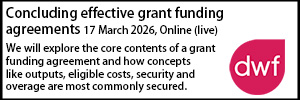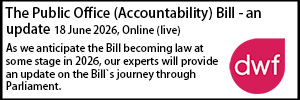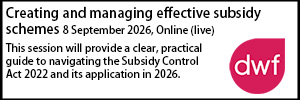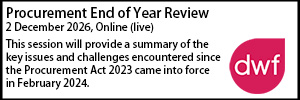Horses for courses
- Details
 Will the Public Contracts Regulations 2015 deliver on the promise of increased flexibility? Kuldip Dhanoya and Rachel Bickler analyse the key provisions.
Will the Public Contracts Regulations 2015 deliver on the promise of increased flexibility? Kuldip Dhanoya and Rachel Bickler analyse the key provisions.
Arguably the most sought after change to the public procurement rules was greater flexibility. A key addition to the new Public Contracts Regulations 2015 (the 2015 Regulations) is the introduction of a choice of procedures for complex contracts. In addition to the well-established competitive dialogue procedure (the default procedure for complex projects) contracting authorities can now opt to apply the new competitive procedure with negotiation or the innovation partnerships procedure.
As the 2015 Regulations enter their fourth month of implementation, we examine in detail the practical use of the two new procedures, namely the competitive procedure with negotiation and the innovation partnership procedures which are available as an alternative to the open, restricted and competitive dialogue procedures.
Competitive procedure with negotiation
In the past, one of the great frustrations for public authorities and bidders alike has been the inability to enter readily into competitive commercial negotiations to identify effective solutions for complex procurement projects, for instance in the case of development schemes, IT solutions or procurements involving complex financing arrangements. While the procurement rules for utilities permitted advertised competitive negotiation, the rules for public contracting authorities were more restrictive.
The competitive procedure with negotiation for complex tenders is therefore a welcome addition. The grounds for justification for its use are the same as those currently available for the competitive dialogue procedure but in addition there are two new additional grounds for justification for either procedure. These are:
- where needs cannot be met without the adaptation of readily available solutions; and
- where the contract includes design or innovative solutions.
There is also greater choice in the way in which the call for tender is made under the competitive procedure with negotiation. For central government bodies the usual publication of a contract notice in the OJEU is to be used. (Although a standard prior information notice (PIN) can still be used to give early warning to the market of an impending procurement exercise). For local authorities and other non-central contracting bodies there is the option of using either a PIN or a contract notice as a means of call for competition. Using a PIN in this manner has a number of benefits, namely:
- Local authorities can batch their procurements annually should they wish to do so and advertise them under one PIN.
- The PIN will remain valid for a 12-month period during which time any bidder can express its interest in the participating in one or more procurement processes, once it is formally commenced through the despatch by the contracting authority of an “invitation to confirm interest”.
- The use of a PIN under these circumstances allows the contracting authority to shorten the deadline for receipt of initial tenders to a minimum of 10 days (subject to the principles of proportionality).
It will mean that the onus is on suppliers to monitor not only contract notices, but also PIN notices to ensure that they don’t “miss the boat” in terms of expressing an interest for a contract. There is also greater flexibility at the negotiation stage to allow a contracting authority to tailor its tender to meet its particular requirements. A contracting authority might for instance accept initial tenders without any negotiation, if it has reserved the right to do so in the contract notice or the invitation to confirm interest (where it has used a PIN as a call for competition). Alternatively, the negotiation can be run in successive stages, to allow for dialogue with bidders and/or to amend elements of the tender provided that there is no change to award criteria or the contracting authority’s advertised minimum requirements. Once final tenders are submitted, no further negotiation or clarification of the tender submission is permitted.
Flexibility in the rules should make it easier for bidders to negotiate to resolve commercial ambiguities and to offer better solutions. However, bidders will need to be mindful that contracting authorities may choose to accept initial bids without further negotiations. Strategically it could be important to put in a complete and best offer at the initial bid stage.
Competitive procedure with negotiation v competitive dialogue procedure
It is anticipated that in the future the competitive procedure with negotiation will be more commonly used than the competitive dialogue procedure. The competitive procedure with negotiation could be an attractive option if a contracting authority is uncertain as to whether negotiations are needed, or desirable, from the outset. There may be instances where the need for negotiation of commercial terms does not emerge until initial tenders are received and specific issues are identified which require further discussion or modification.
The competitive dialogue procedure may still be attractive for complex projects where substantial dialogue is required or where an element of negotiation may be required at preferred bidder stage. One of the changes introduced by the 2015 Regulations is that the term “negotiation” at preferred bidder stage is expressly used. Such negotiation can be carried out in order to “confirm financial commitments, or other terms contained in the tender”, provided that this “does not have the effect of materially modifying essential aspects of the tender or of the public procurement”.
Innovation partnerships procedure
Where a contracting authority wishes both to develop and to purchase genuinely innovative goods, works or services not readily available in the current market under one award process, it may utilise the new Innovation Partnerships procedure. It is an option which could unlock new possibilities for innovators, including early stage start-ups, since it enables a contracting authority to select partners on a competitive basis and develop an innovative solution tailored to its requirements.
The innovative partnerships procedure provides for the appointment of one or more development partners with whom it may develop an innovative solution, together with the option to purchase the outcome of that development process subsequently, without going through a further procurement exercise. The procedure includes a number of key benefits:
- The competitive stage enables identification of the most suitable partners selected on the basis of skills, ability and price.
- The partner or partners can develop the new solution in partnership with the contracting authority. This R&D phase may go through several different stages, during which the number of partners may be reduced based on pre-determined criteria or milestone requirements.
- The final successful solution may then be purchased at the final "commercial" stage of the exercise.
A novel feature of the procedure is that it allows for incremental contractual arrangements for the two distinct phases linked to intermediate targets and periodic payments to the tenderers throughout the procurement process. It does mean that a contracting authority will have to establish commercial arrangements at the outset that are attractive to all parties and which will incentivise participation from innovative entities. A significant issue that will need to be resolved in practice is the treatment of Intellectual Property Rights (IPR). The 2015 Regulations require that the arrangements governing IPR are identified in the documentation – this will necessitate careful consideration of issues such as ownership and use of IPR developed as part of the project.
Practical tips
- Pre-procurement market testing is still a useful preliminary stage for complex tenders.
- Choose the procedure with care. The new negotiated competitive tender procedure may not be suitable for everything.
- Certain options like the right to award the contract at the initial stage or using a staged process have to be indicated from the outset.
- Remember that flexibility can, and should, still ensure equality of treatment, non-discrimination and transparency.
Kuldip Dhanoya is a Senior Associate and Rachel Bickler is a Managing Associate at Nabarro. Kuldip can be contacted on 0114 279 4046 or
Sponsored articles
Unlocking legal talent
Walker Morris supports Tower Hamlets Council in first known Remediation Contribution Order application issued by local authority
Principal Lawyer - Planning, Property & Contract
Legal Director - Government and Public Sector
Contracts Lawyer
Lawyer (Planning and Regulatory)
Senior Lawyer - Planning, Property & Contracts Team
Locums
Poll
15-07-2026 11:00 am
















































